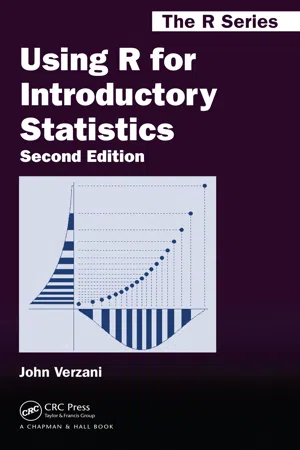
- 518 pages
- English
- ePUB (mobile friendly)
- Available on iOS & Android
Using R for Introductory Statistics
About this book
The second edition of a bestselling textbook, Using R for Introductory Statistics guides students through the basics of R, helping them overcome the sometimes steep learning curve. The author does this by breaking the material down into small, task-oriented steps. The second edition maintains the features that made the first edition so popular, while updating data, examples, and changes to R in line with the current version.
See What's New in the Second Edition:
- Increased emphasis on more idiomatic R provides a grounding in the functionality of base R.
- Discussions of the use of RStudio helps new R users avoid as many pitfalls as possible.
- Use of knitr package makes code easier to read and therefore easier to reason about.
- Additional information on computer-intensive approaches motivates the traditional approach.
- Updated examples and data make the information current and topical.
The book has an accompanying package, UsingR, available from CRAN, R's repository of user-contributed packages. The package contains the data sets mentioned in the text (data(package="UsingR")), answers to selected problems (answers()), a few demonstrations (demo()), the errata (errata()), and sample code from the text.
The topics of this text line up closely with traditional teaching progression; however, the book also highlights computer-intensive approaches to motivate the more traditional approach. The authors emphasize realistic data and examples and rely on visualization techniques to gather insight. They introduce statistics and R seamlessly, giving students the tools they need to use R and the information they need to navigate the sometimes complex world of statistical computing.
Frequently asked questions
- Essential is ideal for learners and professionals who enjoy exploring a wide range of subjects. Access the Essential Library with 800,000+ trusted titles and best-sellers across business, personal growth, and the humanities. Includes unlimited reading time and Standard Read Aloud voice.
- Complete: Perfect for advanced learners and researchers needing full, unrestricted access. Unlock 1.4M+ books across hundreds of subjects, including academic and specialized titles. The Complete Plan also includes advanced features like Premium Read Aloud and Research Assistant.
Please note we cannot support devices running on iOS 13 and Android 7 or earlier. Learn more about using the app.
Information
1
1.1 What is data?
- Only about half the institutions could provide an estimate
- Of those that could, the range of prices went from $11,000 to $125,798
- Under the name “studies,” data is used to make a case about social policy (in two different ways!).
- To investigate variability in prices and transparency, data is collected and summarized.
- In an industry, data demonstrates that forward looking practices can have a substantial effect.
- Data and the information it contains is mined to establish a financial advantage.
1.2 Getting started with R
Installing R
http://cran.r-project.org/. However, most users probably will install R from a distributed binary. These are also available from CRAN. For example, the Microsoft Windows binary is distributed as a self-extracting .exe file. Simply download the file then install it as any other download. For Microsoft Windows users, the standard installation will create a desktop icon and start menu item for opening R. If started this way, R will open to its standard Microsoft Windows GUI, but we suggest using RSTUDIO®, as described next.
Table of contents
- Cover
- Half Title
- Title Page
- Copyright Page
- Contents
- Preface
- 1 Getting started
- 2 Univariate data
- 3 Bivariate data
- 4 Multivariate data
- 5 Multivariate graphics
- 6 Populations
- 7 Statistical inference
- 8 Confidence intervals
- 9 Significance tests
- 10 Goodness of fit
- 11 Linear regression
- 12 Analysis of variance
- 13 Extensions of the linear model
- A.1 Functions
- Bibliography
- Index